Nancymutindi
On this page, you find all documents, package deals, and flashcards offered by seller nancymutindi.
- 5
- 0
- 0
Community
- Followers
- Following
5 items
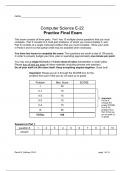
Practice Final Exam
This exam consists of three parts. Part I has 10 multiple-choice questions that you must complete. Part II consists of 4 multi-part problems, of which you must complete 3, and Part III consists of a single multi-part problem that you must complete. Show your work in Parts II and III so that partial credit may be awarded when necessary.
- Exam (elaborations)
- • 14 pages •
This exam consists of three parts. Part I has 10 multiple-choice questions that you must complete. Part II consists of 4 multi-part problems, of which you must complete 3, and Part III consists of a single multi-part problem that you must complete. Show your work in Parts II and III so that partial credit may be awarded when necessary.
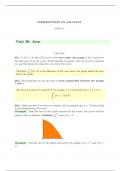
Area
If f(x) ≥ 0, then R b a f(x) dx is the area under the graph of f(x) and above the interval [a, b] on the x axes. If the function is negative, then R b a f(x) dx is negative too and the integral is minus the area below the curve: Therefore, R b a f(x) dx is the difference of the area above the graph minus the area below the graph.
- Class notes
- • 4 pages •
If f(x) ≥ 0, then R b a f(x) dx is the area under the graph of f(x) and above the interval [a, b] on the x axes. If the function is negative, then R b a f(x) dx is negative too and the integral is minus the area below the curve: Therefore, R b a f(x) dx is the difference of the area above the graph minus the area below the graph.
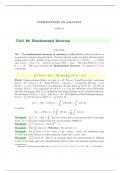
Fundamental theorem
The fundamental theorem of calculus for differentiable functions allows us in general to compute integrals nicely. You have already made use of this theorem in the homework for today. Earlier in the course, we saw that Sf(x) = h(f(0) + · · · + f(kh)) and Df(x) = (f(x + h) − f(x))/h we have SDf = f(x) − f(0) and DSf(x) = f(x) if x = nh. This now becomes the fundamental theorem. It assumes f 0 to be continuous. R x 0 f 0 (t) dt = f(x) − f(0) and d dx R x 0 f(t) dt = f(x)
- Class notes
- • 4 pages •
The fundamental theorem of calculus for differentiable functions allows us in general to compute integrals nicely. You have already made use of this theorem in the homework for today. Earlier in the course, we saw that Sf(x) = h(f(0) + · · · + f(kh)) and Df(x) = (f(x + h) − f(x))/h we have SDf = f(x) − f(0) and DSf(x) = f(x) if x = nh. This now becomes the fundamental theorem. It assumes f 0 to be continuous. R x 0 f 0 (t) dt = f(x) − f(0) and d dx R x 0 f(t) dt = f(x)
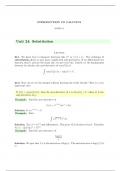
INTRODUCTION TO CALCULUS
We know how to integrate functions like e 6x or 1/(1 + x). The technique of substitution allows to spot more complicated anti-derivatives. If we differentiate the function sin(x 2 ) and use the chain rule, we get cos(x 2 )2x. Indeed, by the fundamental theorem of calculus, the anti-derivative of cos(x 2 )2x is Z cos(x 2 )2x dx = sin(x 2 ) + C .
- Summary
- • 4 pages •
We know how to integrate functions like e 6x or 1/(1 + x). The technique of substitution allows to spot more complicated anti-derivatives. If we differentiate the function sin(x 2 ) and use the chain rule, we get cos(x 2 )2x. Indeed, by the fundamental theorem of calculus, the anti-derivative of cos(x 2 )2x is Z cos(x 2 )2x dx = sin(x 2 ) + C .
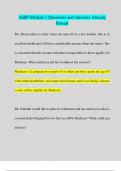
AHIP Module 1 Questions and Answers Already Passed
Ms. Moore plans to retire when she turns 65 in a few months. She is in excellent health and will have considerable income when she retires. She is concerned that her income will make it impossible for her to qualify for Medicare. What could you tell her to address her concern? Medicare is a program for people 65 or older and those under the age 65 with certain disabilities, end-stage renal disease, and Lou Gehrig’s disease so she will be eligible for Medicare.
- Exam (elaborations)
- • 17 pages •
Ms. Moore plans to retire when she turns 65 in a few months. She is in excellent health and will have considerable income when she retires. She is concerned that her income will make it impossible for her to qualify for Medicare. What could you tell her to address her concern? Medicare is a program for people 65 or older and those under the age 65 with certain disabilities, end-stage renal disease, and Lou Gehrig’s disease so she will be eligible for Medicare.
